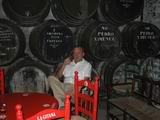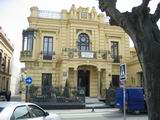Hidden But Not Forgotten (Part 1)

Sherry used to be one of the mainstreams of the wine industry but has lost its way somewhat. It has gone out of fashion, the clamp-down on drink driving, an aversion to higher-alcohol products and the government’s imposition of a punitive tax on fortified wines has impacted the industry dramatically. When was the last time you ordered a sherry?
I am not terribly proud to admit that my first experiences with sherry had little to do with sniffing and appreciating. Rather, my fellow students and I loved the cheaper versions as they provided much-needed warmth in the depths of winter. That is my story and I shall stick to it!
Since then, I have had many opportunities to try a great number of different sherries, from Bristol Medium Cream, in the now in/famous blue bottle, Tio Pepe and a raft of manzanillas, olorosos and amontillados. Confused? Well, so was I until I ventured to the triangle-shaped official region of origin of sherry designated as Jerez DO in March 2007. The three towns that anchor the triangle are El Puerto de Santa Maria, Sanlucar de Barrameda and Jerez de la Frontera (named after the frontier between Christian and Moorish Spain). The architecture in Jerez is a testament to this fact.
My travel companions, Pamela, a Scots winemaker living in Barcelona and Maeve, an Irish financial whiz living in London and I flew into Jerez late at night and then proceeded to fumble our way to dusty Sanlucar in the rented Opel. We finally made it to our hotel, an anachronism in terms of decorations and design – like being in the Wild West. The long bar with dark wood backing, the collection of antiques from the 1800s and the finely-crafted bronze of three horses dragging a dead bull out of an arena were enough to convince us to explore the town.
 Just a few minutes away, in a small square, we discovered the Bar Balbino. Here we ordered fresh tapas and drank sherry as we would drink wine in New Zealand. This was the “real” thing, from the worn and weathered old man “singing” Flamenco on the sidewalk to the huge stuffed bulls’ heads, the autographed photographs of matadors in full flight and the rows of hams hanging from the ceiling, dripping their fat into small plastic cups – this was authentic country Spain. Maybe as we would describe the Mainland and Mainlanders – real people, people of the earth. This was MEAT and SEAFOOD country.
Just a few minutes away, in a small square, we discovered the Bar Balbino. Here we ordered fresh tapas and drank sherry as we would drink wine in New Zealand. This was the “real” thing, from the worn and weathered old man “singing” Flamenco on the sidewalk to the huge stuffed bulls’ heads, the autographed photographs of matadors in full flight and the rows of hams hanging from the ceiling, dripping their fat into small plastic cups – this was authentic country Spain. Maybe as we would describe the Mainland and Mainlanders – real people, people of the earth. This was MEAT and SEAFOOD country.
Of course the gringos were spotted immediately, but Pamela’s Spanish is good and Maeve spent a year in Barcelona studying same, so I felt I wouldn’t be tricked or forced to ingest bull’s brains or sheep’s tail. We played it safe and crack a half-bottle of Fino. This wine is named after the main grape variety grown in the Jerez DO – Palomino Fino. Fino Sherry should be consumed young, just like white wine, when it is fresh and vibrant. Also, if the bottle has been opened, the wine should be stored in a cool, dark place and generally consumed within a few days – just like white wine.
 The Fino wines from Sanlucar are called Manzanilla. Essentially they are made from the same grape variety and in the same manner. However, Manzanilla is from Sanlucar, whereas Fino is from Jerez. Sanlucar is directly on the coast and the influence of the sea breezes supposedly adds a tangy, salty taste to Manzanilla. Of course we three had to make the comparison and ordered a half-bottle of Delgado Zuleta “La Goys” Manzanilla Pasada. This was fresh and more full-bodied than the Fino with a long palate, whiffs of sea breezes, sea –weed and salt.
The Fino wines from Sanlucar are called Manzanilla. Essentially they are made from the same grape variety and in the same manner. However, Manzanilla is from Sanlucar, whereas Fino is from Jerez. Sanlucar is directly on the coast and the influence of the sea breezes supposedly adds a tangy, salty taste to Manzanilla. Of course we three had to make the comparison and ordered a half-bottle of Delgado Zuleta “La Goys” Manzanilla Pasada. This was fresh and more full-bodied than the Fino with a long palate, whiffs of sea breezes, sea –weed and salt.
When there is wine, food cannot be far away. In the home of Tapas we explored various dishes of delicious fresh mussels, shrimp (fried and in garlic sauce). A bit like sitting at Yum Cha, it was just too easy to continue ordering and ordering. The barman, with a wry, knowing smile, continued to chalk up our account on the counter top. Our third half-bottle of sherry, another Manzanilla was a little more commercial and less satisfying – Barbadillo Solear Manzanilla. An alcohol content of 18% and the tangy nature of the wine is a great accompaniment to food. Another visitor, a golden spaniel, strolled in, searching for scraps. We finally left with a glow to our cheeks and a full tummy, having paid only 43 Euro for the privilege.
Fortified, we headed out to explore further. At this time, most of the bars were closing down but we did manage to squeeze in another Manzanilla tasting, this time the famous La Gitana Manzanilla in its shapely bottle, before we were sent on our way. What a superb start to our 5-day adventure in the sherry triangle.










phil2b4ever - 17 years ago
Very interesting article, similar to my own experience in Jerez but I am anxious to discover where I can purchase GOOD Manzanilla (i.e. La Gitana) in New Zealand. I love this infectious wine and love to keep a bottle in the fridge for the summer aparitif.
I live in Hawkes Bay but would be grateful of any information on this subject.